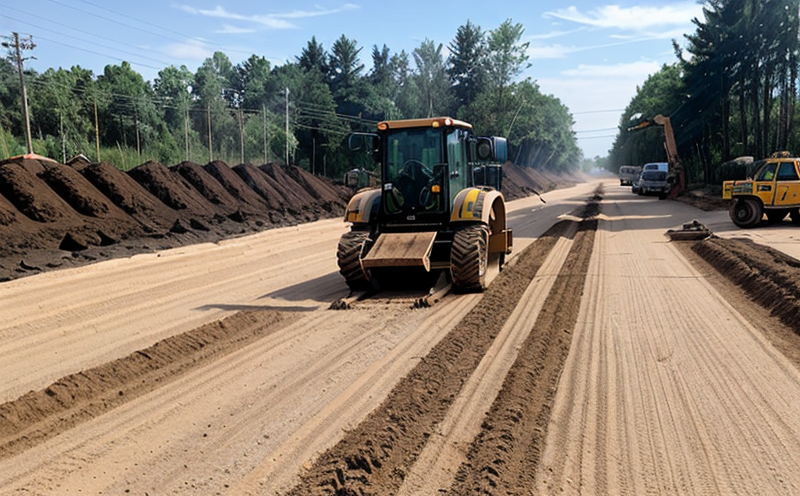Subgrade preparation inspection
The subgrade is a fundamental component in the construction of any civil engineering project. It forms the base that supports structures such as roads, pavements, and buildings. Proper subgrade preparation ensures stability, durability, and longevity of these structures. This service focuses on inspecting and ensuring the quality of the subgrade before it is covered with the intended pavement or structure.
Subgrade inspection involves several critical steps to ensure that all standards are met. The process begins with site surveying where the ground conditions are thoroughly evaluated using geotechnical surveys, soil borings, and other relevant data collection methods. This helps in determining the suitability of the existing subgrade for construction purposes.
The next step is excavation and grading. Here, any necessary earthworks or structural reinforcements are carried out to meet design specifications. The use of advanced machinery such as excavators, bulldozers, and graders ensures precision and efficiency. Once the ground has been prepared, it undergoes a series of quality checks including compaction testing.
Compaction is crucial in ensuring that the subgrade can support heavy loads without sinking or shifting over time. Various methods are employed to achieve this, such as rolling with heavy rollers or using vibration techniques. The degree of compaction depends on the type of soil and project requirements but typically aims for a percentage above 95% of maximum possible density.
After compaction testing, samples may be taken from different layers of the subgrade to analyze their composition and moisture content. This helps in adjusting future preparations if necessary and provides valuable data for quality control purposes.
The inspection process also involves checking for any signs of water intrusion or frost heave which could compromise the integrity of the structure later on. If issues are found, corrective measures will be suggested immediately to prevent potential failures during construction.
In summary, subgrade preparation is a critical stage in ensuring the success and longevity of infrastructure projects. By carefully preparing the ground beneath new structures, we lay down a strong foundation that can support significant loads while maintaining stability against environmental factors like moisture and temperature changes.
Why It Matters
The quality of subgrade preparation directly impacts the performance and durability of buildings and infrastructure. Poorly prepared subgrades often lead to premature failure, costly repairs, and potential safety hazards. Ensuring that the subgrade meets all necessary standards through rigorous inspection processes is therefore essential.
For instance, inadequate compaction can result in settlement or cracking of pavements leading to uneven surfaces which affect traffic flow and pedestrian comfort. Additionally, improperly treated subsurfaces may allow water seepage into foundations causing structural damage over time.
From an economic perspective, investing in thorough subgrade inspections saves money by preventing costly retrofits down the line. It also promotes safety by reducing risks associated with unstable ground conditions that could endanger workers and passersby alike.
Moreover, adhering to industry standards ensures compliance with local regulations and best practices thus protecting both the developer's reputation and public health.
Scope and Methodology
The scope of subgrade preparation inspections encompasses various aspects including site evaluation, excavation, grading, compaction testing, sample collection for analysis, and visual inspection. Each step plays a crucial role in guaranteeing that the ground is suitable for construction purposes.
Site evaluation involves gathering detailed information about the existing conditions using geotechnical reports, soil borings, and other relevant documents. This helps identify any potential challenges such as uneven terrain or presence of underground utilities before proceeding with excavation work.
Excavation follows after thorough site assessment where earthmoving equipment is used to remove excess materials or level out irregularities in the ground surface. Grading then takes place ensuring a smooth and flat base suitable for subsequent layers of construction.
The compaction process ensures that the subgrade can withstand heavy loads without sinking or shifting over time. Various methods are employed depending on soil type such as rolling with heavy rollers or using vibration techniques until desired density levels are achieved.
Sample collection allows for detailed analysis of different parts of the subgrade allowing adjustments if needed and providing crucial data points for future reference.
Environmental and Sustainability Contributions
Incorporating sustainable practices into subgrade preparation inspections not only enhances project performance but also contributes positively to environmental conservation efforts. Using recycled materials during excavation can reduce waste sent to landfills while promoting resource efficiency.
By adhering strictly to specified compaction percentages, we minimize subsidence risks thereby reducing the need for additional maintenance work later on thus extending the lifespan of built environments and minimizing carbon footprints associated with frequent repairs or replacements.
The use of advanced technology in inspection processes allows for more accurate measurements and assessments resulting in less material waste during construction activities. Furthermore, by ensuring that the subgrade is prepared correctly from the outset, we reduce energy consumption required for future interventions thus promoting sustainable urban development practices.





